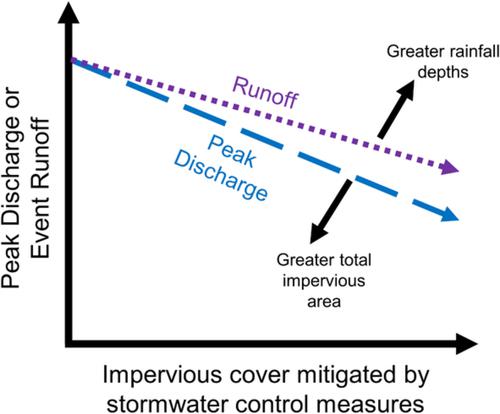当前位置:
X-MOL 学术
›
Hydrol. Process.
›
论文详情
Our official English website, www.x-mol.net, welcomes your
feedback! (Note: you will need to create a separate account there.)
Stormwater control impacts on runoff volume and peak flow: A meta‐analysis of watershed modelling studies
Hydrological Processes ( IF 2.8 ) Pub Date : 2020-05-28 , DOI: 10.1002/hyp.13784 Colin D. Bell 1 , Jordyn M. Wolfand 1 , Chelsea L. Panos 2 , Aditi S. Bhaskar 3 , Ryan L. Gilliom 2 , Terri S. Hogue 4 , Kristina G. Hopkins 5 , Anne J. Jefferson 6
Hydrological Processes ( IF 2.8 ) Pub Date : 2020-05-28 , DOI: 10.1002/hyp.13784 Colin D. Bell 1 , Jordyn M. Wolfand 1 , Chelsea L. Panos 2 , Aditi S. Bhaskar 3 , Ryan L. Gilliom 2 , Terri S. Hogue 4 , Kristina G. Hopkins 5 , Anne J. Jefferson 6
Affiliation

|
Decades of research has concluded that the percent of impervious surface cover in a watershed is strongly linked to negative impacts on urban stream health. Recently, there has been a push by municipalities to offset these effects by installing structural stormwater control measures (SCMs), which are landscape features designed to retain and reduce runoff to mitigate the effects of urbanisation on event hydrology. The goal of this study is to build generalisable relationships between the level of SCM implementation in urban watersheds and resulting changes to hydrology. A literature review of 185 peer‐reviewed studies of watershed‐scale SCM implementation across the globe was used to identify 52 modelling studies suitable for a meta‐analysis to build statistical relationships between SCM implementation and hydrologic change. Hydrologic change is quantified as the percent reduction in storm event runoff volume and peak flow between a watershed with SCMs relative to a (near) identical control watershed without SCMs. Results show that for each additional 1% of SCM‐mitigated impervious area in a watershed, there is an additional 0.43% reduction in runoff and a 0.60% reduction in peak flow. Values of SCM implementation required to produce a change in water quantity metrics were identified at varying levels of probability. For example, there is a 90% probability (high confidence) of at least a 1% reduction in peak flow with mitigation of 33% of impervious surfaces. However, as the reduction target increases or mitigated impervious surface decreases, the probability of reaching the reduction target also decreases. These relationships can be used by managers to plan SCM implementation at the watershed scale.
中文翻译:

雨水控制对径流量和峰流量的影响:流域建模研究的荟萃分析
数十年的研究得出结论,一个流域的不透水地表覆盖率与对城市河流健康的负面影响密切相关。最近,市政当局一直在推动通过安装结构性雨水控制措施(SCM)来抵消这些影响,结构性雨水控制措施是为了保留和减少径流以减轻城市化对事件水文学的影响而设计的景观特征。这项研究的目的是在城市流域的SCM实施水平与水文变化之间建立可概括的关系。对全球185个经过分水岭规模SCM实施的同行评审研究进行了文献综述,以确定52项适合进行荟萃分析的建模研究,以建立SCM实施与水文变化之间的统计关系。水文变化量化为相对于(几乎)没有SCM的相同控制流域,有SCM的流域之间的暴风雨径流量和峰值流量减少的百分比。结果表明,在流域中,每减少1%的SCM减少的不透水区域,径流就会减少0.43%,峰值流量减少0.60%。在不同的概率水平上,确定了产生水量度量标准变化所需的SCM实施值。例如,峰值流量降低至少1%的可能性为90%(高置信度),而不渗透表面的缓解率为33%。然而,随着减少目标的增加或减少的不渗透表面的减少,达到减少目标的可能性也减少。
更新日期:2020-05-28
中文翻译:

雨水控制对径流量和峰流量的影响:流域建模研究的荟萃分析
数十年的研究得出结论,一个流域的不透水地表覆盖率与对城市河流健康的负面影响密切相关。最近,市政当局一直在推动通过安装结构性雨水控制措施(SCM)来抵消这些影响,结构性雨水控制措施是为了保留和减少径流以减轻城市化对事件水文学的影响而设计的景观特征。这项研究的目的是在城市流域的SCM实施水平与水文变化之间建立可概括的关系。对全球185个经过分水岭规模SCM实施的同行评审研究进行了文献综述,以确定52项适合进行荟萃分析的建模研究,以建立SCM实施与水文变化之间的统计关系。水文变化量化为相对于(几乎)没有SCM的相同控制流域,有SCM的流域之间的暴风雨径流量和峰值流量减少的百分比。结果表明,在流域中,每减少1%的SCM减少的不透水区域,径流就会减少0.43%,峰值流量减少0.60%。在不同的概率水平上,确定了产生水量度量标准变化所需的SCM实施值。例如,峰值流量降低至少1%的可能性为90%(高置信度),而不渗透表面的缓解率为33%。然而,随着减少目标的增加或减少的不渗透表面的减少,达到减少目标的可能性也减少。











































 京公网安备 11010802027423号
京公网安备 11010802027423号